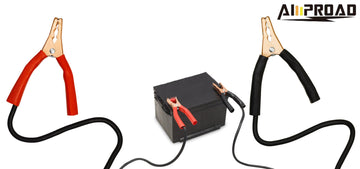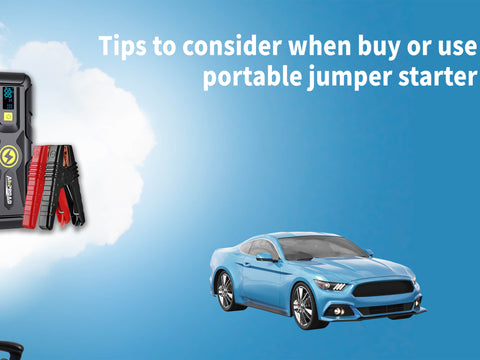
When it comes to reviving a drained or dead car battery, two essential tools come into play: jump starters and battery chargers. While both serve the purpose of providing power to a vehicle's battery, they differ in their mechanisms and intended uses. Understanding the distinction between these two devices is crucial for ensuring the proper maintenance and longevity of your car's battery.
Jump Starters
A jump starter, also known as a battery booster or jump box, is designed to provide a powerful burst of energy to a depleted battery, enabling your vehicle to start. These portable devices typically feature a high-capacity lithium-ion or lead-acid battery, along with heavy-duty cables and clamps that connect directly to your car's battery terminals.
The primary function of a jump starter is to deliver a high-amperage jolt of electricity, temporarily bypassing the drained battery and supplying enough power to crank the engine and get it running. This process, commonly referred to as "how to boost a car," is a lifesaver when you find yourself stranded with a dead battery, whether due to leaving your lights on, electronic accessories draining the battery, or simply an aging battery nearing the end of its life.
Battery Chargers
Unlike jump starters, battery chargers are designed to slowly and steadily recharge a depleted battery over an extended period. These devices are typically plugged into a wall outlet or a vehicle's 12-volt power source and connected to the battery terminals via charging cables.
Battery chargers work by supplying a regulated flow of electric current to the battery, gradually replenishing its charge. This process can take several hours or even days, depending on the battery's state of discharge and the charger's output capabilities.
The primary advantage of using a battery charger is that it allows for a more controlled and complete recharging process. By providing a slow, steady charge, battery chargers help to ensure that the battery's cells are evenly charged, reducing the risk of overcharging or damaging the battery due to excessive heat buildup.
Moreover, many modern battery chargers come equipped with advanced features such as automatic voltage regulation, temperature compensation, and multi-stage charging algorithms. These features help to optimize the charging process, prolonging the battery's lifespan and ensuring optimal performance.
When to Use a Jump Starter vs. a Battery Charger

While both jump starters and battery chargers serve essential roles in maintaining your vehicle's battery, the choice between the two depends on the specific situation and your immediate needs.
Jump starters are ideal for emergency situations when you need to get your vehicle started quickly. They provide the necessary power boost to crank the engine, allowing you to drive to a safe location or an auto repair shop. However, it's important to note that jump starter does not significantly charge the battery; they merely provide a temporary solution.
On the other hand, battery chargers are recommended for long-term battery maintenance and recharging. If your battery has been deeply discharged or has been sitting idle for an extended period, a battery charger is the optimal choice. By slowly and steadily replenishing the battery's charge, chargers help to ensure that the battery is properly conditioned and ready for reliable performance.
Expert Recommendations
According to the experts at Optima Batteries, one of the leading manufacturers of automotive and marine batteries, it's best to use a battery charger as soon as possible after jump start your vehicle. Alternators, while capable of recharging batteries to some extent, are not designed to recover deeply discharged batteries effectively. Repeatedly attempting to recharge a severely drained battery through the alternator can decrease the lifespan of both the alternator and the battery itself.
The recommended approach is to jump-start the vehicle when necessary, drive it to a safe location, and then connect the battery to a charger for a complete recharge. This practice not only ensures that the battery is properly charged but also helps to maintain the health and longevity of the vehicle's electrical system.
Considerations for Storing and Using Jump Starters One of the advantages of jump starters, especially the smaller lithium-ion portable models, is their portability and ease of storage. These compact devices can be easily stored in your vehicle's glove box, under the seat, or in the trunk, ensuring they're readily available when needed.
However, it's important to note that extremely cold temperatures can affect the performance of jump starters, potentially weakening their potency. To mitigate this issue, experts recommend recharging or testing portable jump starters every six months or so, ensuring they're ready for use when the need arises.
When comparing and selecting a jump starter, consider factors such as capacity (measured in peak cranking amps or PCA), amperage, and available interface ports for charging devices. Higher capacity jump starters are better suited for larger engines or multiple jump-start attempts, while additional USB ports or 12-volt outlets can provide added versatility for powering electronic devices.
For those seeking a reliable and well-rounded jump starter, the AMPROAD iRock 40 Jump Starter is a popular choice among automotive enthusiasts and professionals. This portable device boasts an impressive 4,000 peak cranking amps, capable of boosting vehicles with up to a 10.0L gasoline or 10.0L diesel engine. Additionally, it features a 24000mAh portable charger for electronic devices, multiple USB charging options, built-in emergency LED functions (flashlight, SOS, strobe), and a 12-volt port for powering DC devices. With reverse polarity protection, spark-proof technology, and a durable EVA carrying case, the AMPROAD iRock 40 Jump Starter is a versatile and reliable companion for any road trip or emergency situation.
Whether you opt for a jump starter, a battery charger, or both, having the right tools on hand can make all the difference in ensuring your vehicle's battery stays healthy and reliable. By understanding the distinct roles and capabilities of these devices, you can be better prepared to handle dead battery situations and maintain the longevity of your car's electrical system.


